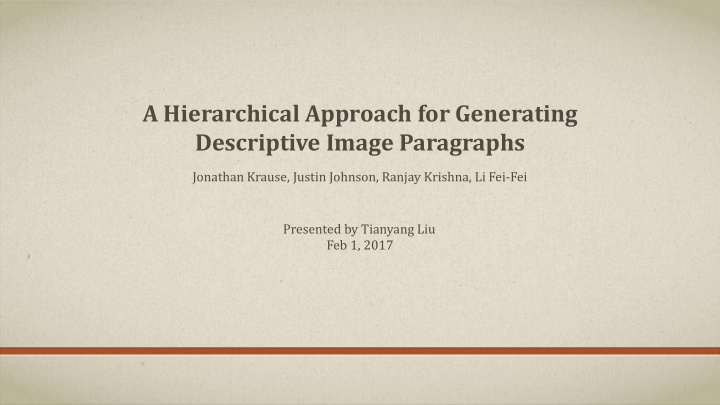



A Hierarchical Approach for Generating Descriptive Image Paragraphs Jonathan Krause, Justin Johnson, Ranjay Krishna, Li Fei-Fei Presented by Tianyang Liu Feb 1, 2017
IMAGE CAPTIONING - One sentence description - A great amount of detail is left out - Multi-sentence description (dense captioning) - Solves the lack of detail problem, but sentences are not coherent - Paragraph description
RELATED WORK #1 - Baby talk: Understanding and generating image descriptions. [G. Kulkarni, V. Premraj, S. Dhar, S. Li, Y. Choi, A. C. Berg, and T. L. Berg. 2011] Figures from G. Kulkarni, V. Premraj, S. Dhar, S. Li, Y. Choi, A. C. Berg, and T. L. Berg. Baby talk: Understanding and generating image descriptions. In CVPR, 2011
RELATED WORK #2 - Generating Multi-sentence Natural Language Descriptions of Indoor Scenes [Dahua Lin, Sanja Fidler, Chen Kong, Raquel Urtasun. 2015] Figures from Generating Multi-sentence Natural Language Descriptions of Indoor Scenes, Dahua Lin, Sanja Fidler, Chen Kong, Raquel Urtasun. 2015
OVERVIEW OF MODEL
REGION DETECTOR - The image is first run through a pre- trained CNN (16-layer VGG) to extract CNN features - Given the features, the Region Proposal Network will output the features of M most confident regions - Details of RPN on next slide
REGION PROPOSAL NETWORK Figure from J. Johnson, A. Karpathy, and L. Fei-Fei. DenseCap: Fully convolutional localization networks for dense captioning. In CVPR, 2016.
REGION POOLING - Given a set of vectors v 1 , …, v M ∈ R D , each describing the features of a different region in the input image - Will learn a projection matrix W pool ∈ R P x D and bias b pool ∈ R P to create a single pooled vector - Take the maximum at each element - The result pooled vector is fed into the hierarchical recurrent neural network language model
HIERARCHICAL RECURRENT NEURAL NETWORK Includes 2 parts: - Sentence RNN - Word RNN
SENTENCE RNN Single-layer LSTM with hidden size H = 512 2 Tasks: - Decide the number of sentences S that should be in the generated paragraph - Produce a P -dimensional topic vector for each of these sentences. Image from http://colah.github.io/posts/2015-08-Understanding-LSTMs/
WORD RNN Two-layer LSTM with hidden size H = 512 Figures from O. Vinyals, A. Toshev, S. Bengio, and D. Erhan. Show and tell: A neural image caption generator. In CVPR, 2015.
EVALUATION AND EXPERIMENT Dataset comprised of 19,551 image and annotation pairs - Images are from MS COCO and Visual Genome - Annotation were collected on Amazon Mechanical Turk - Broken down to 14,575 training, 2,487 validation, and 2,489 testing images Baselines: - Sentence-Concat - Concatenates 5 sentence captions from a model trained on MS COCO captions - Purpose is to demonstrate difference between sentence-level and paragraph captions. - Image-Flat – NeuralTalk - Template – similar to BabyTalk - Regions-Flat-Scratch – uses flat language model that’s initialized from scratch - Regions-Flat-Pretrained – same as above except using a pretrained language model Model checkpoints are selected based on best combined METEOR and CIDEr score on validation set
QUANTITATIVE RESULTS - Poor performance by Sentence-Concat shows the fundamental difference between single- sentence captioning and paragraph generation - Template performed well on METEOR and CIDEr, but not so on BLEU-3 and BLEU-4. It indicates the template method is not good enough at describing relationships among objects in different regions - Image-Flat and Regions-Flat-Scratch each improved the results further. - Regions-Flat-Pretrained outperformed on all metrics, pre-training works - The paper’s method scored highest on all metrics except BLEU -4. Possibly due to Regions- Flat- Pretrained’s non-hierarchical structure is better at exactly reproducing words immediately at the end and beginning of sentences
QUALITATIVE RESULTS
PARAGRAPH LANGUAGE ANALYSIS - Similar average length and variance as human descriptions. The other 2 models fell short especially on variance of length, i.e. robotic - Paper’s method used more verbs and pronouns than the other automatic methods, and performed close to humans. That shows the robustness of describing actions and relationships in an image, and keep track of context among sentences - Lots of room for improvement on Diversity for automatic methods
EXPLORATORY EXPERIMENT
THANK YOU!
Recommend
More recommend